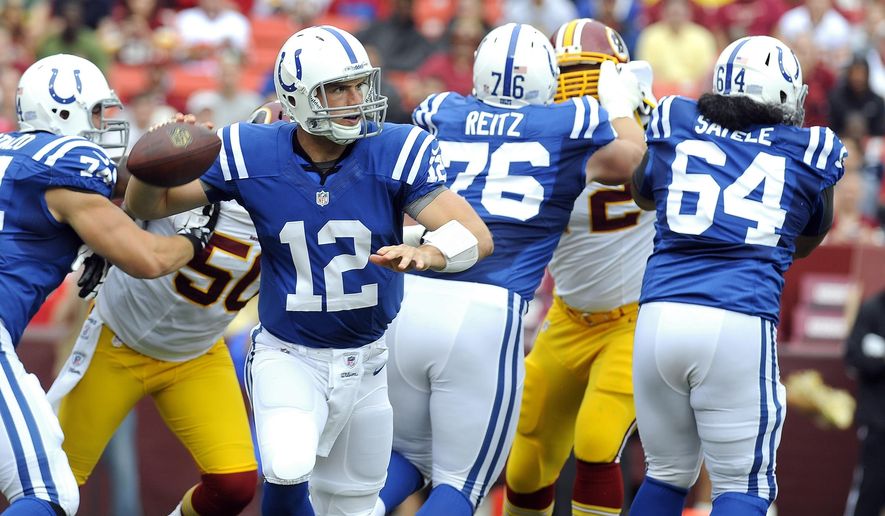ASHBURN — Hugh Thornton understands where Andrew Luck is coming from. The offensive lineman is trying to make a comeback with the Redskins after several injury-plagued years with the Indianapolis Colts led to retirement in 2017.
Thornton says it was frustrating, going through rehab multiple times to overcome recurring injuries. He felt stuck in a cycle, the same one Luck described as he announced his retirement late Saturday. The two even rehabbed together at Indianapolis.
“You feel like you play to get hurt to rehab,” Thornton said. “You play to get hurt to rehab. It never stops.”
Like the rest of the NFL, the Washington Redskins were shocked Luck stepped away from the game at just 29 years old. Hailed as his generation’s “sure-fire” quarterback prospect in 2012, Luck now becomes one of the sport’s all-time “what ifs” as he walks away, unwilling to attempt another return from a nagging calf and ankle injury.
But while the circumstances surrounding Luck’s departure may be surprising, his story serves as a reminder that, in the NFL, even the “can’t-miss” quarterbacks need the right situation to succeed.
It’s a truism that applies to just about any signal-caller in the league — including the Redskins’ Dwayne Haskins, who officially lost the starting job Sunday to Case Keenum.
Washington fans may be disappointed the No. 15 overall pick won’t be starting Week 1, but history favors caution with promising young QBs — especially with an offensive line as shaky as the Redskins’ line is without Trent Williams.
“It’s hard, it’s hard,” coach Jay Gruden told The Washington Times. “As a coordinator, you can have all these great dropback plays. ’Hey we can get this, this and we can hit this guy on the high cross,’ but it takes time. And if you can’t protect, your quarterback is going to get hit a lot.
“Hopefully, we’ll get it all cleaned up.”
Gruden maintains neither Williams’ absence nor the condition of the offensive line played a factor in deciding Keenum should start over Haskins. Rather, the Redskins felt Haskins wasn’t ready and that he still has much to learn.
There are plenty of examples of a quarterback losing confidence after being pummeled behind a subpar line. David Carr, the No. 1 overall pick in 2002, saw his career altered because of a notoriously poor offensive line in Houston. Former Redskin Robert Griffin III, taken in the draft right after Luck, saw his career derailed by injuries, too.
In Indianapolis, the Colts did a horrendous job of investing in the offensive line — relying on Luck’s arm to lead them to victories. Under former Colts general manager Ryan Grigson, the Colts drafted just 10 offensive linemen between 2012 and 2016 — only four before the fourth round. Further, Grigson took only six offensive linemen his first four years, none in the first round.
Luck suffered along the way, taking an inordinate amount of punishment from 2012 to 2016.
In those seasons, Luck was sacked 156 times — 11th-most in the league. During that same span, the Colts allowed 578 quarterback hits in 80 games, 70 of which Luck appeared in. The Colts routinely ranked in the top five each year in QB hits allowed.
Surprisingly, Luck went his first three seasons without missing a game, but the hits began to add up. Over his career, Luck dealt with: a torn cartilage in two ribs, a partially torn abdomen, a lacerated kidney, a concussion, a torn labrum and his latest calf injury that caused him to retire.
Luck even played through his shoulder injury in 2016 — something he vowed to never do again. He missed the entire 2017 season recovering from surgery.
Interestingly enough, Thornton argued the Colts’ offensive line shouldn’t be viewed as a scapegoat.
“Whether you have a good offensive line or a bad offensive line, you’re going to get hurt,” Thornton said. “It’s a game where it’s a 100% injury rate. To put that on the line is ridiculous. I think it’s case by case. People get hurt stepping out of their car in the morning. It’s just the way things go sometimes.”
Thornton may have a point.
Luck arguably did himself no favors with an aggressive, even reckless, style of play that invited hits. But the point remains: Indianapolis failed to significantly invest in the offensive line in Luck’s formative years.
Luck took so much punishment that he admitted to reporters he lost his love for the game.
“I’m in pain,” Luck said. “I’m still in pain.”
Many teams dream of enjoying the success the Colts have had under Luck. Indianapolis made the playoffs in four of his seven seasons — winning 53 of 86 games with Luck under center.
But he’s stepping away in what should be the prime of his career. It’s a harsh reminder of the toll the game exacts on those who suit up, whether as a role player in the trenches, like Thornton, or as a former No. 1 pick playing the most glamorous position in all of team sports.
• Matthew Paras can be reached at mparas@washingtontimes.com.




Please read our comment policy before commenting.